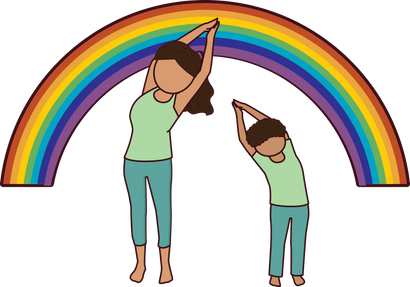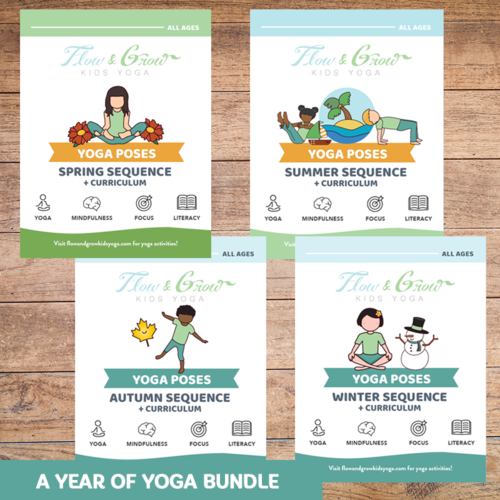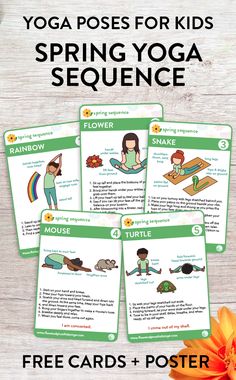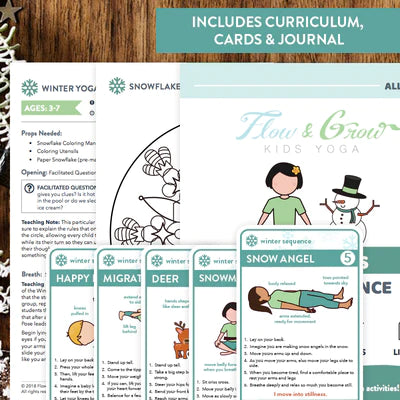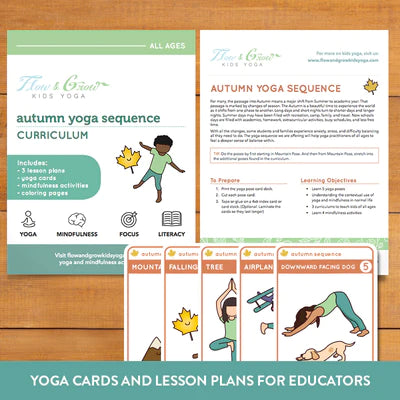Your Cart is Empty
22% off Automatically at checkout when you spend $5 of more!
22% off Automatically at checkout when you spend $5 of more!

3 Important Considerations for Teaching Kids Yoga Asana
by Lara Hocheiser June 29, 2021 4 min read
By Kathryn Boland, Flow and Grow Kids Yoga Blog Manager and 95-hour Training Graduate

When adults who practice yoga observe or begin to teach kids yoga, they pretty quickly see that it’s not the same thing as yoga for general adults. Kids/youth have different temperaments and interests, but also different physical abilities and needs. Here are three things to keep in mind (and in no way an exhaustive list) when teaching yogaasana(postures) to kids, tweens, and teens. Teaching by these guidelines can help realize yoga’s potential to nurture young people, but also -- as a first important principle -- do no harm.
- Weight bearing with caution
Kids’ bones are still ossifying, the outer wrapping converting from softer cartilage to the harder material of adult bone. Postures that create weight bearing on the hands and wrists -- such as Plank Pose, Downward Facing Dog Pose, and arm balances -- must therefore be taught with full awareness and caution. Have elementary-aged children hold these poses for no more than two to three breaths. That can keep the class atmosphere dynamic enough to more effectively engage their bodies and minds, as well!
As kids get a bit older (middle school and older elementary age), and they gain more awareness of their own body parts, you can cue them to power up through their legs more so that their upper bodies aren’t taking on as much of the work in the poses (and from that less pressure on the hands and wrists). In Downward-Facing Dog, for example, you can ask them to pull their hips up to the sky and feel their legs holding them strong. In Plank Pose, you can ask them to hold their bellies strong and the lift back of their legs lifting up. These sorts of cues can also further encourage the kinesthetic awareness that’s beginning to grow in these years of life.

2. Consent is key
This concept is particularly key when working with infants and young toddlers (yes, they can do yoga too!), because they most often need a good deal of physical guidance into poses. Even at this tender age, their bodies know what’s best for them -- and we must listen as they signal us accordingly.
Gently, slowly -- and playfully, with joy -- help them into poses, and watch for any physical tension or resistance to your touch and adjustments. Respond to that immediately if it occurs. This is crucial for not only physical safety, but so that they develop trust and comfort -- but also how to say “no” -- when it comes to their bodies in relationship to others at this early stage of life. This can have life-long ripple effects.
This concept is also meaningful with elementary-school aged children, tweens, and teens. They spend so much of their days being told what to learn and when, where to go and when, what to do and when. Yoga can be a collaborative space where they can exercise their creativity, leadership, and authentic social/emotional expression (within limits of not doing harm to their peers). How can you color and shape your class with their ideas, co-creating it with them? How can you put them in positions whereby, with your guidance, they can lead their peers in turns?

3. Mind energetics of their “season of life”
Ayurvedais yoga’s sister science of health, wellness, and greater harmony with the earth and all other beings. Within that science are the doshas --vata, pitta,andkapha. We can draw a parallel here to the modern framework of the ectomorph, mesomorph, and endomorph body types.
Think, for a moment, about tendencies of young children -- they love sweets, can be stubborn and love routine, and sometimes keep their “baby fat” for years after infancy. That’skapha: grounded, loving comforting things, tending to extra bodyfat, sometimes resistant to change. Now think on tweens and teens -- prone to moodiness, sometimes impulsive, learning to set goals and with ambitions emerging, gaining muscle and losing their baby fat. That’spitta: firey, ambitious, and tending towards a high level of muscle tone.

Ayurveda teaches us that like increases like. In other words, doing things with pitta qualities will increase pitta within us, and the same with the other two doshas. In contrast, doing things with the qualities of vata (light, airy, changing often) or pitta can pacify kapha. Vata and kapha qualities can pacify pitta. In our teaching, that might mean keeping classes for elementary age and younger quick, dynamic, and with poses that have upwards energy. Make transitions with joy and full energy, and offer tools to kids to help them transition more harmoniously if they have any trouble.
For teens and tweens, try beginning with some active poses to burn off excess energy -- and then shift to more of a slow flow or even restorative style. Ending with journaling and discussion can be grounding, reflective, as well as offer opportunities to teach meaningful yoga philosophy concepts (such as non-harming, non-attachment, truthfulness, and surrendering to things that are out of your control). When we teach to the realities of where young people are in their lives, we can watch the practice support them and bring them closer to their full potential!
Interested in learning more about Anatomy and Physiology in kids yoga? We have a course on that, soon this summer and again this fall. Take it individually or within our 95-hour Kids Yoga Teacher Training, or mix and match courses as best serves you! Questions? Email the Teacher Trainer Lara Hocheiser, or book a call with her here!

Leave a comment
Comments will be approved before showing up.
Also in Kids Yoga Blog

How Social and Emotional Learning and Yoga Help Kids Breathe Through Big Emotions
by Kane SEO April 21, 2025 4 min read
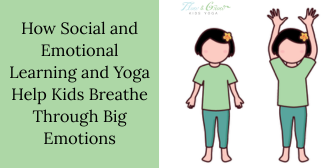
How Social and Emotional Learning and Yoga Help Kids Breathe Through Big Emotions
by Kane SEO April 14, 2025 4 min read
In classrooms and communities around the world, educators and parents alike are placing a growing emphasis onsocial and emotional learning. And for good reason: helping children understand, manage, and express their emotions in healthy ways is just as critical as teaching them to read or do math.

Power of Yoga for Kids: How It Helps Them Grow, Focus, and Thrive
by Kane SEO March 25, 2025 5 min read
In today’s fast-paced world, children are often exposed to stressors from a young age, whether it’s academic pressure, social challenges, or the overwhelming influence of digital devices. This can impact their physical, mental, and emotional well-being.
Ultimate Kids Year of Yoga Bundle
bundlespricey-contentdigital-resourcesearly-childhood-yoga-mindfulnesselementary-yoga-mindfulnesskids-yoga-resourcesmiddle-high-school-yoga-mindfulnessseasonal-yogayoga-cards
Ultimate Kids Year of Yoga Bundle
5 reviews
5.0 / 5.0
(5) 5 total reviews
$45.00
Ultimate Kids Year of Yoga Bundle
5 reviews
5.0 / 5.0
(5) 5 total reviews
$45.00
Kid’s Sun Salutation Yoga Cards
digital-resourcesearly-childhood-yoga-mindfulnesselementary-yoga-mindfulnesskids-yoga-resourcesliteracyunder-15yoga-cards
Kid’s Sun Salutation Yoga Cards
3 reviews
4.33 / 5.0
(3) 3 total reviews
$10.00
Kid’s Sun Salutation Yoga Cards
3 reviews
4.33 / 5.0
(3) 3 total reviews
$10.00
Yamas and Niyamas: Successful Relationships with Self & Others (tweens and teens)
pricey-contentdigital-resourceskids-yoga-resourceslesson-plansmiddle-high-school-yoga-mindfulnessmindfulness
Yamas and Niyamas: Successful Relationships with Self & Others (tweens and teens)
2 reviews
5.0 / 5.0
(2) 2 total reviews
$49.00$55.00
Yamas and Niyamas: Successful Relationships with Self & Others (tweens and teens)
2 reviews
5.0 / 5.0
(2) 2 total reviews
$49.00$55.00
